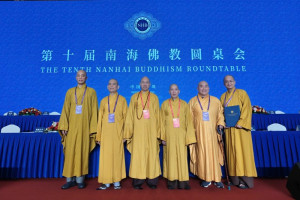
(RNS) — On a misty morning, the Baha’i Temple of South America, nestled in the foothills of the Andes above the sprawling city of Santiago, Chile, can appear as a mysterious, otherworldly object, perhaps a visitor from another planet.
When I visited the temple recently, I was not prepared for the power of this transcendent space.
As a visitor, you move toward the temple first from below it, treading along a series of nine pathways and gardens that radiate through the landscape. The paths are not direct, so you experience the temple from different perspectives, noting how light strikes its variegated exterior surface, which almost looks like a chrysalis. As you come closer, the 10,000 exterior cast-glass panels, each a different size and shape, glint with reflections on their surfaces and are replicated back into the earth by nearby pools of still water. When you arrive next to the temple and look up at the panels of clear-to-opaque glass, the effect is alive with light.
The American Institute of Architects and the Royal Architectural Institute of Canada recently recognized this unique work of architecture for its innovative design and path-breaking use of materials.
The AIA bestowed its 2017 Innovation Award for Stellar Design, describing the temple as “South American poetry at its best.”
In giving it the 2017 Innovation in Architecture Award, the RAIC described the temple as “a project of such extraordinary ambition.” The design of the temple by the Toronto-based firm Hariri Pontarini Architects was selected in an international design competition that drew 180 submissions from 80 countries.
This first Baha’i temple in South America was designed to reflect the beliefs of this religion, which sees itself as open to people of all faiths and no faith. The parameters were fairly straightforward: It needed to have nine sides with nine portals, symbolizing its access to anyone who wishes to enter.
Early on in the design process, architect Siamak Hariri (who explains the history of the project in a TED Talk ) gravitated to a circular building with no front and no back, which could be approached from any direction. Hariri describes the temple’s geometry as reflecting the faith’s emphasis on “completeness and perfection” and allowing anyone to express their beliefs, given that Baha’is do not have clergy.
“A servant is drawn unto Me in prayer until I answer him,” Hariri said, quoting a Baha’i text. “If his prayer is answered, his very being becomes embodied light.”
The architect wanted to literally make the temple glow with “embodied light.” The temple enclosure is conceived as two layers of glass and marble, separated by a layer of steel structure. The exterior layer is borosilicate cast glass, which has a milky appearance that captures ambient light and appears to literally glow. The interior surfaces of the nine-sided dome are covered with translucent white marble from Portugal. Nine metal-clad doors encircling the worship space pivot open to admit worshippers into the temple, which can accommodate 600.
The temple structure was designed to mitigate the effects of earthquakes, which are common in the region.
As you step through one of the nine portals, the temple mushrooms over your head. It is impossible not to throw your head back and gaze at the swirling vortex of glowing marble that spirals high above you. Slivers of clear glass separate each of the nine veils of light and cascade clear sunlight along their gently warped surfaces. The entire dome ensemble appears to pinwheel in a counterclockwise motion. At the very center is a small, circular oculus that displays the Arabic words “The Greatest Name.” The temple interior’s forms and surfaces literally move as they stand still. It’s as if you are spiritually elevated into the welcoming folds of the dome, lifted into the heaven of its space.
Hariri says that he set out to create a “new kind of sacred space.” It’s an ambitious goal, given the thousands of years that human beings have been creating houses of worship. In the year since its completion, the Baha’i Temple of South America has become a work of architecture for the ages.

Arabic word for 'Greatest Name' at the dome oculus.

Detail of canopy and cast-glass wall over a portal.

Combinations of natural materials throughout the temple interior.

Temple reflection in a still pool.
By Michael J. Crosbie/religionnews.com




